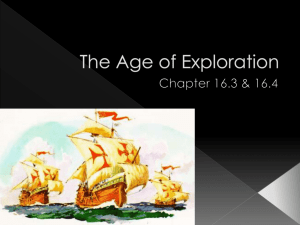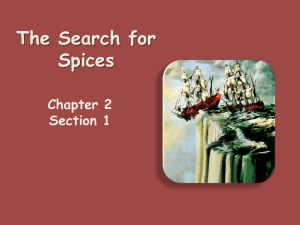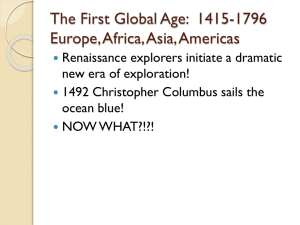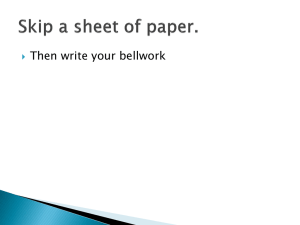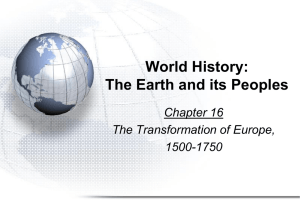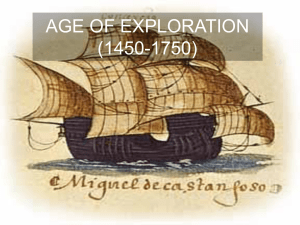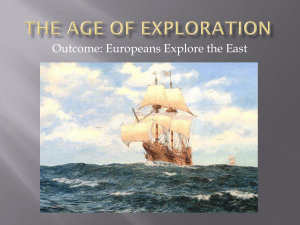Age of Discovery
advertisement
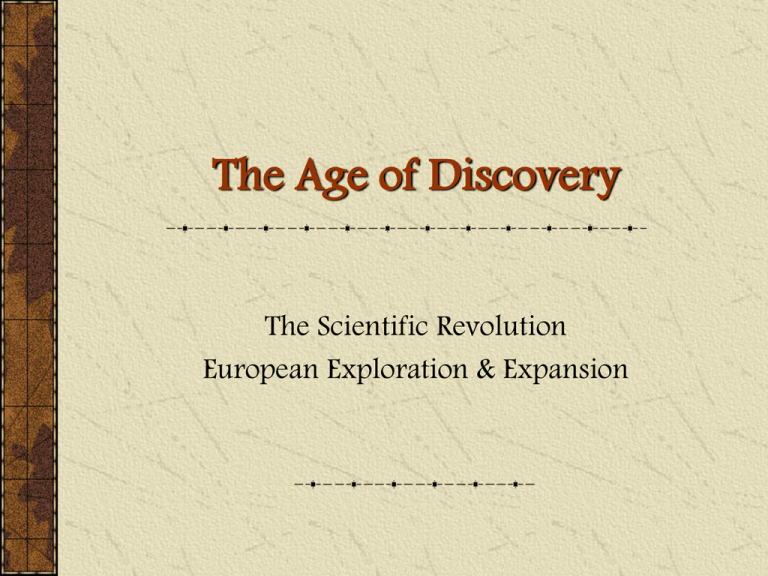
The Age of Discovery The Scientific Revolution European Exploration & Expansion The Scientific Revolution Essential Questions: What were the factors that contributed to the Scientific Revolution? How did Copernicus, Kepler, and Galileo challenge traditional thought? What were some of the important scientific discoveries of this period? “Magic” Alchemists – tried to use magic to change substances • Lead to gold Astrologers – believed the stars affected human events Roger Bacon Franciscan Monk Studied at Oxford and Paris Favored a system of scientific experimentation rather than following traditional religious thought Became known as Dr. Mirabilis or “wonderful teacher” Renaissance encouraged: Curiosity Investigation Discovery Led to Scientific Revolution Scientists formed conclusions based on observation New tools and instruments to observe and measure Instruments– barometer, microscope, telescope, thermometer, air pump. Astronomy, Physics, and Anatomy Ptolemy– Roman astronomer Geocentric theory- Planets revolve around the earth Copernicus – heliocentric theory Planets revolve around sun Kepler and Galileo Kepler proved Copernicus’ theory Galileo made improvements to telescope Newton – laws of motion and gravity Vesalius – studied anatomy and circulation The Triumph of the New Science Descartes “I think, therefore I am.” Great gains in mathematics, sciences, & philosophy Believed in using only known facts to arrive at conclusions Francis Bacon Believed scientific theories could be developed through observation Other scientific discoveries Calculus – Newton and Liebnitz Microscope – Leeuwenhoek (discovered bacteria) Chemistry – Robert Boyle The Foundations of European Exploration Essential Questions: What are the technological advances that made European exploration possible? Describe the effect of the Commercial Revolution. What role did mercantilism play in the colonies? Improvements in Technology Mapmaking New world, Africa and Asia added to maps Navigation Development of compass New ships Traveled farther, faster, and under greater variety of weather conditions Economic Changes Commercial Revolution Standardization of money encouraged international trade and banking Joint – Stock Companies • Companies that owners raised money for by selling shares • As company value went up, price of shares went up People could make money by sharing in other businesses • Dividends paid to investors Mercantilism Balance of trade To increase country’s wealth • Receive more gold than paid to other nations Tariff – import taxes Subsidies • Grants of money to create exportable goods • Showed government support of domestic industry The role of colonies Colonies were not allowed to manufacture or import goods Could only create raw materials Social Change Curiosity and spirit of discovery Hope of wealth or better way of life Escape religious persecution or spread religion Voyages of Portugal and Spain Essential Questions: What did the early Portuguese explorers accomplish? How did the voyages of Christopher Columbus influence the world? Explain why the Atlantic slave trade prospered. Portugal’s First Explorers Africa Slave, gold, ivory trade Africans participated in slaves trade • Sold conquered tribes into slavery Prince Henry – “The Navigator” Found African trade route Main goal was to find gold for Portugal Inspired Portugal’s exploration Dias and Vasco da Gama Overseas trade route to India and East Indies Christopher Columbus Italian explorer, sailed for Spain Studied Marco Polo and Ptolemy’s writings Thought the fastest way to India was to sail west First European to discover new world Vikings discovered America in 1000 AD, but no one knew about it Landed at San Salvador The Impact of Columbus’ Voyages Columbian Exchange Name for trade between Europe and the Americas American foods were introduced in Europe Spanish brought horses to the Americas Also brought smallpox and other diseases • Killed millions Sparked a desire in the rest of Europe to explore new world Dividing the New Lands Treaty of Tordesillas Treaty that divided trade in the Americas between Spain and Portugal • Spain took most of Central and South America and Philippines • Portugal claimed lands in Africa, Asia, and East Indies Vespucci, Balboa, and Magellan Amerigo Vespucci Believed that Columbus did not discover Asia Explored North American continent First to call it the New World America was named after him Balboa South Sea Magellan Pacific Ocean – named by Magellan, means peaceful Proved that the western lands were a New World, not a part of Asia First to sail around world Portuguese Expansion Conquered lands in East Indies Allowed Portuguese to control others’ access to Asian goods and markets The Slave Trade Triangular trade Merchants shipped goods to Africa Slaves were sent to the Americas Merchants sent products to Europe African kingdoms and slavery Not all African kingdoms participated in slave trade Some native populations in Africa were depleted The Portuguese Empire Weakens Lacked wealth and population needed to sustain expansion and colonization Battles cost money and lives Portugal’s population was too small to replace needed people The Spanish and Dutch Empires Essential Questions: How did Spain extended its power abroad and at home? Why were the Dutch successful in the 1600s? Analyze why the Spanish Empire declined. Spain’s Colonial Empire Conquests Ponce de Leon • Explored Florida and Caribbean Cortés conquered Aztecs • Defeated Montezuma at Tenochtitlán and built Mexico City in its place Colonial government and society Spanish brought new things to new world • Horses • Guns • Disease Weakened native Aztec populations Spain grew wealthy Spain’s Colonial Rivals French, Dutch, and English wanted a share of Spain’s wealth and lands Charles V Holy Roman Emperor Had conflicting demands between: • Being king of Spain • Supporting German aims • Defending Christian Europe Realized it was too much for one man Divided lands among members of his family Philip II King of Spain Controlled every facet of government Directed Spanish Inquisition Defeated Ottomans Defeated by England • Attempted to invade with the Spanish Armada (Large Navy) • Lost control of the Netherlands The Rise of the Dutch The Netherlands break from Spain Practiced guerrilla warfare Northern provinces declared independence from Spain Dutch society Seafaring people Religious tolerance Lively cultural center The Dutch colonial empire Trade was controlled by Dutch East India Company Did not force their own culture or religious beliefs on other societies The Spanish Empire Declines Growing population Increased costs and shortage of food, clothing, and housing Expulsion of Jews and Moriscos (Moorish converts to Christianity) Many skilled bankers Business people Commercial leaders and artisans Flow of money out of Spain

